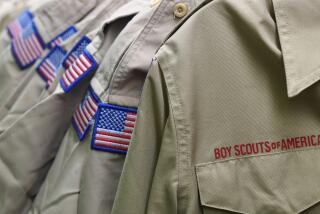Horns of Plenty: Scouts’ Annual Antler Auction Turns Into Big Business
- Share via
JACKSON, Wyo. — Like most American communities, this friendly mountain town at the foot of the majestic Teton Range has a Boy Scout troop. And like most Boy Scouts, members of Jackson’s Troop 200 hold an annual fund-raiser.
At that point, similarities between Jackson and the rest of the country come to an end.
Eschewing traditional car washes, cookie sales, paper drives and raffles, the Jackson Scouts raise their money through the annual Jackson Hole Antler Auction.
Their fund-raiser, held on the third Saturday of May each year, is the only regular auction of elk antlers in the United States. It has become a major stop for buyers on the international antler market, with bidders from all over the United States and South Asia overflowing the town square.
Big Business
Along the way, the sale has turned into big business. The annual profit has grown each year.
But this year, the Scouts set a new record. In two hours of bidding, their auction took in $111,382.50.
That figure does not include numerous sales by private sellers who horned in, so to speak, on the Scouts’ market by selling truckloads of antlers at the fringe of the auction.
Why would people shell out so much for elk antlers?
Jeremiah Wright, 13, a Star Scout in Troop 200’s Moose Patrol, knew the answer. “Well, they use ‘em for jewelry and trophies,” he began. “But the biggest buyers are the Asians, ‘cause they make antlers into aphro-, aphro-, aphrodisiacs.”
‘Love Potions’
At this point, Wright was blushing a bright red. “That means a love potion,” he giggled.
Sure enough, scattered around the blue-jeaned, cowboy-booted crowd of 500 people at the sale were a dozen or so Asian men in dark suits and black ties, discreetly holding up cards to bid on the largest lots of antlers.
For the most part, these buyers politely rebuffed questions, saying they knew little English, although they appeared to have little trouble following the rapid-fire patter of auctioneer Earl Hardeman.
Pak Heesung, a trader from South Korea, looked up long enough to explain that most antlers purchased at the auction are shipped to Korea or Hong Kong, where they are ground into “powders” by pharmaceutical concerns.
The exact use of these antler powders was the subject of some disagreement.
Americans present agreed that the Asians turn the antlers into aphrodisiacs. Indeed, the U.S. government’s flyer on elk antlers declares that “people purchase antlers for decorations, belt buckles, bolos, buttons and love potions.”
In some Asian cities, shoppers can buy small bottles, identified as “horn extract” or something similar, with labels promising that the product will enhance lovemaking.
Traditionally, rhinoceros horns have been most valued for this purpose in the Orient. But unlike elk, which drop their antlers each spring, rhinos must be killed to obtain the horn.
Asian bidders here, however, said the antler extract is sold as a calcium substitute and a general aid to good health.
“It’s like vitamins,” Pak Heesung said. “Take in spring and fall. No colds.”
For the people of Jackson, of course, the reason Koreans want to buy excess antlers does not matter much.
“We’re delighted to have buyers, that’s all,” said Jim Wallace, the Scout leader who coordinated this year’s sale.
Jackson’s antler auction is a neat example of turning a lemon into lemonade.
Located in a splendidly scenic alpine valley just south of the Yellowstone and Grand Teton national parks and nearly surrounded by the 24,000-acre National Elk Refuge, Jackson is awash in antlers each spring.
Elk come down from the mountains by the thousands each fall to winter in the refuge and other valleys. Between March and May each year, the bulls drop their antlers to make room for the new set that grows each summer. As a result, antlers are to Jackson what paper work is to Washington--a commodity that builds up faster than people can get rid of it.
This small town is full of ingenious uses of antlers, from the four 15-foot-tall antler arches at the corners of the town square to the antler door handles on the Million-Dollar Cowboy Bar to the shop that sells nothing but antler-furniture--chairs, couches, tables, lamps, chandeliers and the inevitable hat racks.
$15 a Pound
But by the mid-1960s, antler supply here had greatly outstripped demand. Searching for a solution, the elk refuge cut a deal with the Boy Scouts. The Scouts could have a special permit to collect antlers and sell them each spring. In return, the Scouts turn over about 90% of their earnings to the refuge for feed.
This year, industrious Scouts found more than 7,000 pounds of antlers, creating towering hills of horn around the town square. The auction started with sales of more than 200 small lots to collectors, jewelers and taxidermists for prices of at least $15 a pound.
The big bidders, representing Asian drug firms, held back, waiting for lower prices. But it was not to be. When the auctioneer got to the biggest single lot of the sale, a truck bed loaded with 4,020 pounds of antler, bidding raced at a dizzying pace.
In the end, trader Byung T. Chung was the winner with a price of $14.70 a pound, or $59,094 for the lot.
The Boy Scouts and their leaders were elated. Chung said he was dismayed. “Price too high,” he said quietly. “I lose money. But where else to buy this much?”
More to Read
Sign up for Essential California
The most important California stories and recommendations in your inbox every morning.
You may occasionally receive promotional content from the Los Angeles Times.













